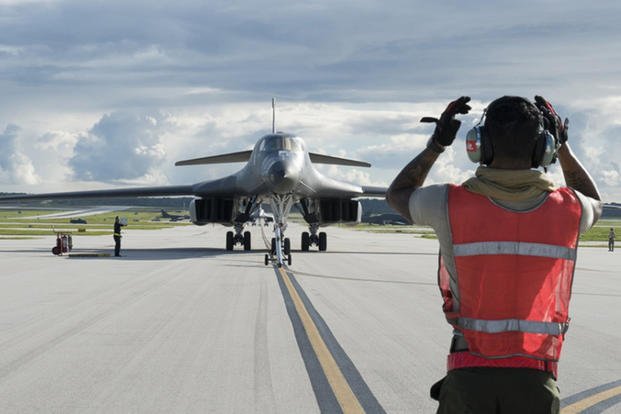In its quest to retire old weapons and aircraft, the U.S. Air Force has an unexpected advocate: former Secretary of State Hillary Clinton.
In a piece published in Foreign Affairs magazine Friday, Clinton, a former U.S. senator from New York and Obama administration official, proposed that the Air Force, and the military as a whole, hasten plans to "retire aging weapons systems or close bases that have outlived their usefulness" in an effort to free up resources to spend on future technologies.
Read Next: Army Beats 2020 End Strength Goal Despite Major Recruiting Roadblocks
"Among the highest priorities must be to modernize the United States' defense capabilities. In particular, moving away from costly legacy weapons systems built for a world that no longer exists," Clinton said in the piece, "A National Security Reckoning: How Washington Should Think About Power."
"Deep savings -- potentially hundreds of billions of dollars over the next decade -- can and should be found by retiring legacy weapons systems," she said. "New technologies such as artificial intelligence are rendering old systems obsolete and creating opportunities that no country has yet mastered but many are seeking."
She cited China as the primary competitor to the U.S. in this field.
Clinton took a shot at the F-35 Joint Strike Fighter program, which has been projected to cost more than $1 trillion over its 50-year service lifetime, and said the Air Force should look to buy fewer F-35s in favor of the B-21 Long Range Strike Bomber (LRSB) program. The Air Force is the largest customer for the stealth fighter aircraft, with hopes to procure 1,763 of the F-35's A-variant.
The Pentagon "sank so much time and money into the project that turning back became unthinkable, especially since the F-35 is the only fifth-generation aircraft currently being manufactured in the United States," she said. "And because the plane directly and indirectly supports hundreds of thousands of jobs across hundreds of congressional districts in nearly every state, it has legions of defenders in Congress."
"The U.S. Air Force will have to focus less on short-range tactical fighter planes and more on long-range capabilities," she continued. "That means it won't need nearly as many F-35s as planned, but it should welcome the arrival of the B-21 Raider, a long-range bomber under development that is designed to thwart advanced air defenses."
In its 2021 budget request, the Air Force proposed retiring multiple aircraft, including a number of KC-10 Extenders, KC-135 Stratotankers and B-1B Lancer bombers, that need repeated structural work; officials have recommended divesting portions of these fleets early in order to avoid upkeep costs for old planes.
The Air Force plans to have 165 to 175 bombers in its inventory once the B-21 comes online. That future inventory is expected to be solely made up of the new LRSB and the B-52 Stratofortress. But some officials maintain that more are needed.
Gen. Tim Ray, the head of Air Force Global Strike Command, has often proposed a bomber force of more than 200 aircraft.
"We've said publicly that we think we need 220 bombers overall -- 75 B-52s and the rest B-21s, longterm," Ray told Air Force Magazine earlier this year. The service plans on retiring its B-1s and B-2 Spirits in the early-to-mid 2030s.
"The size of the bomber force is driven by the conventional requirement, and then we manage the nuclear piece inside of that, based on treaty and policy. In the context of the National Defense Strategy and great power competition, 220 is where we think we need to go," he told the magazine in May.
A number of lawmakers have backed the call for additional B-21s, such as Sen. Tom Cotton, a Republican from Arkansas. Cotton in the past has even suggested the B-21s replace the B-52 fleet, despite the Air Force's plan to keep the plane flying into the 2050s.
Congress, however, has been skeptical of letting the service retire weapons systems early until there are capabilities to backfill their role.
For example, the Air Force has tried numerous times over the last decade to retire its A-10 Warthog close-air support aircraft.
The once seemingly logical proposal, however, launched a firestorm in 2014 when lawmakers -- led by former Air Force colonel turned Republican congresswoman Martha McSally, who joined forces with the late Sen. John McCain of Arizona -- rushed to save the beloved plane from mothballs. Years later, the fleet is being refurbished with new wings instead of being sent to the boneyard.
"There are some circumstances [under which] only the A-10 is going to keep Americans alive," said McSally, who was appointed to the Senate in December 2018 as a replacement for McCain.
"So why would we want to get rid of that until we have a suitable alternative?" McSally told Military.com in an interview earlier this year. "It's got the ability to fly well into the 2040s, and we're going to keep fighting to make sure it does."
-- Oriana Pawlyk can be reached at oriana.pawlyk@military.com. Follow her on Twitter at @Oriana0214.
Related: Congress Wants a 'Manhattan Project' for Military Artificial Intelligence














